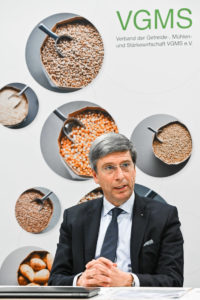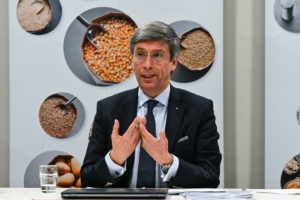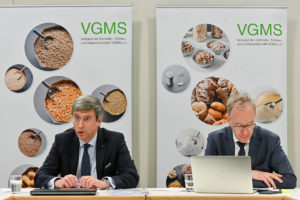Regional starch products: Your first choice when it comes to improving environmental compatibility

At the latest since “Fridays for Future”, the flood of plastic packaging, resource consumption or global warming have been buzzwords labelling the impact of our modern lifestyle on the world. The starch industry offers some solutions to the pressing questions of our time. In January 2020, at a press conference held during the International Green Week in Berlin, Dr Peter Haarbeck, Managing Director of the German Grain, Mill and Starch Industry Association, VGMS e.V. and Gustav Deiters, spokesman for the VGMS executive committee and managing director of Crespel & Deiters GmbH & Co. KG, drew attention to the key significance of regional starch raw materials for trend-setting solutions.
Wheat proteins are a building block in feeding the world

The global population is growing and, with it, the need for food. To be in a position to sustainably feed about ten billion people in 2050, the availability of high-quality proteins plays a crucial role. In the starch industry, high-quality proteins are obtained from the renewable raw material of wheat. So-called “textured proteins” are produced by extrusion and have a wide range of applications in the food industry.
“The market for textured plant proteins is growing, as are their areas of application. Extrusion offers the food industry an important tool to ensure a surface-saving protein supply for the people”, Gustav Deiters, speaker of the VGMS chairmanship, explains in Berlin. Textured proteins are used for enriching protein. They are also used to reproduce specific textures and, in addition to optimising sensory properties, they add the desired stability to the end-consumer products when used in vegetarian and vegan products, e.g. as meat or fish substitutes.
Well packed, thanks to starch – benefits for protecting resources & a good ecological balance

Packaging plays a central role in nearly all areas of business and private life; it ensures safe transportation and protects high-value goods, regardless of whether food or car parts. The demand for sustainable packaging solutions made of paper, cardboard and paper board has been growing for years. Reasons for this are found in constantly increasing online trade and the export of goods as well as in the discussion regarding the wide-spread avoidance of plastic waste in the first place.
Using corrugated board as packaging is attractive in more way than one,” Gustav Deiters says. “On the one hand, at just under 700 kg CO2/t, the carbon footprint of corrugated board is five times smaller than that of plastic, which is about 3,500 kg CO2/t. Secondly, corrugated board is recycled up to 20 times. And, thanks to the use of starch-based, high-performance adhesives, it is 100 per cent recyclable. Packaging is good for the ecological balance, not only directly but also indirectly: It allows us to protect valuable goods and, as such, resources,” Deiters continues.
Raw material wheat: An agricultural product with multi-functional properties

Starch and vegetable proteins are obtained from regionally-grown wheat. These wheat-based raw materials are produced in the EU, are GMO-free and, thanks to their proximity to the starch producers, generate low transport emissions.
The wheat grain has a high nutritional-physiological nutrient value and consists of about 70 per cent starch and 14 per cent protein with high-quality amino acids, in addition to unsaturated fatty acids, fibres, vitamins, and minerals.
With a recovery rate of 99 per cent, the starch industry achieves almost complete utilisation of the raw material, thereby guaranteeing efficient and resource-saving handling of this renewable resource.
The high-quality starch and protein products from domestically-sourced raw materials play an essential role in reducing the feed protein shortage in the EU. Wheat-based liquid feeds ensure balanced, nutrient-reduced feeding, while at the same time complying with environmental regulations such as the Fertiliser Ordinance.
Starch products can contribute to a longer shelf life for food, thereby counteracting food waste.
Future trends, innovations and quality assurance in the starch industry

The demand for alternatives to petrochemical products is constantly growing. Here, the industry’s task is to offer innovative and novel solutions that flexibly respond to consumer needs, while at the same time treating nature and the environment in a resource-conserving manner. Plant-based starch products can make an important contribution to sustainably solving climate and environmental protection issues, for example when used as natural binders and coating systems. Solutions must be found across the entire value chain, and innovations can contribute significantly to supporting farmers and processors in coping with the consequences of more stringent Fertiliser Ordinance regulations.
Environmentally-critical ingredients such as mineral oil products can gradually be replaced by renewable, biodegradable starch-based ingredients in numerous technical areas. The European starch industry is continuously working on innovations and expanding its starch products’ range of functions and applications in both the technical and food sector. The objective is to satisfy ever-changing customer and consumer needs in a sustainable and environmentally friendly way and to provide answers to pressing questions with new applications.
The official press release and more background information can be found here on the website of the German Association of the Grain, Milling and Starch Industry, VGMS e.V.
January 2020